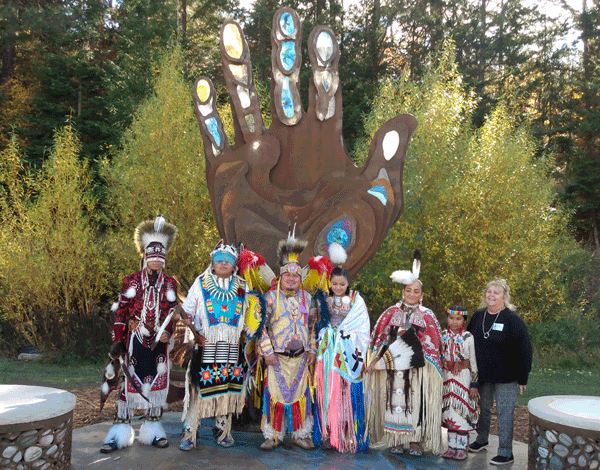Lin McJunkin
NWDC is pleased to share the art and ideas of Lin McJunkin for our next NWDC Artist Interview of 2024.
Lin McJunkin is an artist and science educator who feels compelled to advocate for the health of our planet and its inhabitants. Her sculpture focuses the heat of her commitment, as well as that of her glass kilns and metal torches, on the effects of our behavior on the environment.
After working with glass molds at Pilchuck International Glass School outside of Stanwood, WA, she developed a modern approach to the ancient pate de verre (paste of glass) method of casting forms with spiky edges for her gallery pieces. In her larger outdoor works for public places, she also employs a kiln-carving approach in order to emboss patterns into the backs of large panels of glass.
How were you introduced to art?
I’m a self-starter. At the age of 4, I crayoned my own “cave paintings” on my bedroom wall, to my mom’s laughing surprise. In grade school, I was lucky to have a teacher who gave structured art lessons and displayed prints to encourage our understanding and appreciation of fine art. My dad also showed me the commercial value of art and the personal pride of creating work that others value. He offered me my first commission, to reproduce my amateur Chinese brush painting of a pine tree, done in Mrs. Harrison’s 5th grade art class, on a silk screen. Never underestimate the value of an early art education (or paying for artwork)!
Where do you find inspiration when creating new work?
"Art comes to an artist as a gift, inspired by forces beyond our grasp. It should be circulated to others as a gift, too.” (Unknown) In pre-dream states, I often receive this “gift” in the form of word phrases that I later translate into visual symbols. In more prosaic moods, I envision brain electrodes receiving NPR radio waves that deliver news of the wonders, alarms and atrocities of the world disorder and connecting those messages to my heart and hands to convey my environmental and social concerns.
What do you consider your greatest artistic achievement?
My greatest artistic achievement isn’t the use of refined materials or advanced techniques but rather in learning to collaborate with others, to build teams that provide skills I lack but need, and to help me define my objectives and refine my messages to encourage action on the part of the viewers.
"Valley of Our Spirits" - (with Milo White and Jay Bowen, Upper Skagit Tribal elders)- 23' x 6' x 6' - Mt. Vernon, WA Riverwalk Park | "Creator's Law" - (with Milo White, Yakama Nation Tribal Artists) - Roslyn, WA 16' x 20' installation.
What is the quality you most like in an artist?
I have a background in the sciences, so I appreciate the experimental spirit shared by scientists and artists. I admire the posing of questions, the testing of ideas, the evaluation and refinement of results, and the repetition of this process in service to perfection of style and content. There are many roles that artists can play in society, but that of artist-activists who advocate on behalf of our earth and its inhabitants is the highest level to me, especially when they inspire others to move from awareness to questioning to action for positive change.
Which living artist do you most admire?
Argentine-born, Italian glass artist Sylvia Levenson’s powerful glasswork was the first to inspire me with the narrative potential of glasswork. She tells ghastly stories of personal and political strife in gorgeous and often humorous ways that I seek to emulate.
If you could change one thing about yourself, what would it be?
I’m not superstitious, but since I live a charmed personal life, I’m reluctant to even think about changes, lest I jinx myself. And as long as my 92-year-old mother’s health holds up, a certain person doesn’t win the election, various peace deals are made and our climate stops warming, that happiness will remain unchanged.
What is your most treasured possession?
As I celebrate the 50th anniversary of bloodletting and skin burning in service to my art, I commemorate the acquisition of my first cheap glass cutter and a tiny jeweler’s kiln, whose descendants remain my twin most treasured possessions. With the cutter, I disassemble glorious sheets of colored glass that I manipulate and embellish in various ways, then entrust to the vagaries of the Goddess of Heating and Cooling who presides over the kiln process, and from which emerges something new and, hopefully, exciting.
Who has had a significant influence on your work?
My father continued to influence me posthumously through a magazine article he annotated by climate guru Bill McKibben I found when I was cleaning out his office in 2009. It reaffirmed our concerns about our environment, and I set out to make a memorial glass piece warning of the dangers of our warming climate. The positive response to that piece set me on the path of creating dozens of pieces on the same theme.
With Broken Hearts, We Persevere- experimental pate de verre "wraps" 6-10. | Tidal/Power - (base by Milo White)- 7' x 3' x 18" artist's collection.
How has your studio practice changed?
When a college housemate moved out, I inherited her stained-glass supplies and spent the next 10 years creating framed leaded and copper-foiled glass. When my wood framer moved, I developed a method of internally reinforcing copper-foiled panels so that they were strong enough to be free-form, without frames. The gift of a tiny jeweler’s kiln hooked me on glass fusing, and the purchase 12 years ago of my 5’ x 3’ x 3’ kiln, along with a summer session at Pilchuck International Glass School, allowed me to devise large pate de verre pieces that animated my flat work into a third, sculptural dimension. In the process, I went from creating small gallery objects for personal use into working with a metal colleague to make large public art pieces that are commissioned by public entities throughout the West.
What is your idea of perfect happiness?
I fear that a “perfectly” happy world would lack the challenges that force humans to be resourceful and innovative for the common good. But I would like to see a world in which we can disagree without being disagreeable, and converse without conflict, as we collaborate and compromise to ensure a just, peaceful and verdant world for us all.




